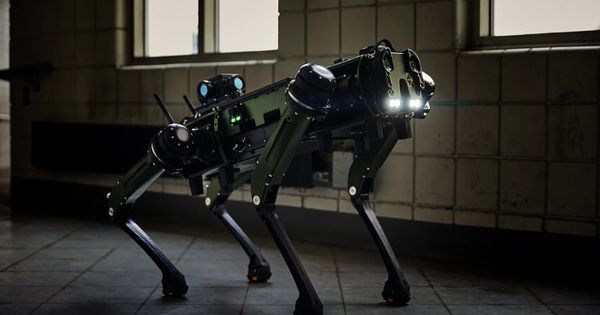Every day, AI and robotics advance in ways that push the limits of what was once considered science fiction. What was once confined to movie screens—autonomous machines hunting human targets—is now a reality in military labs across the world. The fusion of AI and robotics within the military-industrial complex raises critical ethical and security concerns, especially when we consider the possibility of this technology falling into the wrong hands.
A recent art exhibit in Japan puts these concerns front and center. A chained robot dog aggressively pursues human targets, restrained only by a metal tether. It doesn’t stop. It doesn’t reconsider. It follows orders without question. This is not an exaggeration of what’s possible—it’s a warning of what is already happening.
The military’s push for AI-powered autonomous weapons is accelerating. The U.S. Marines are actively testing armed robotic dogs, and advanced AI is being developed to control everything from unmanned drones to battlefield decision-making. The argument from military leaders and defense contractors is simple: We must stay ahead of adversaries. But at what cost?
The Risks We Cannot Ignore
Autonomous Weapons Lack Moral Judgment
AI does not have ethics, emotions, or an understanding of human life. It follows objectives without question, without hesitation, and without the ability to reconsider. That alone should give us pause. Military AI systems are programmed to identify and neutralize threats, but what happens when the data is flawed? When the parameters are wrong? When an AI-powered drone mistakes a group of civilians for enemy combatants? These are not theoretical risks; we’ve already seen deadly errors from automated systems in warfare.
The Threat of Bad Actors
Technology, once developed, cannot be kept under lock and key forever. AI and robotic warfare capabilities are not exclusive to any one government or institution. As with any military advancement, what is cutting-edge today can be reverse-engineered and used by adversaries tomorrow. Worse, AI-powered weapons in the hands of rogue states, terrorist organizations, or cybercriminals would be a nightmare scenario. The chain keeping these machines restrained could be broken by those with far fewer ethical considerations than democratic governments claim to uphold.
The Loss of Human Oversight
Proponents of military AI argue that human oversight will always be part of the equation. But history tells us otherwise. Automation, once introduced, tends to expand as it proves effective. As AI grows more sophisticated, the temptation to remove human decision-making from the loop will only increase. In high-pressure combat situations, where speed is critical, AI-driven systems will be given more autonomy. At that point, it’s no longer a question of if mistakes will happen, but when—and at what scale.
Where Do We Draw the Line?
The idea that AI and robotics will become central to modern warfare is no longer a matter of speculation. It’s happening. The question is whether we, as a society, are thinking critically enough about the consequences.
Are we comfortable with machines making life-and-death decisions? What safeguards are in place to prevent the misuse of this technology? And most importantly, are we prepared for what happens when the chain is removed—whether by an oversight, a malfunction, or intentional action by those who wish to cause harm?
We cannot afford to be passive observers in this conversation. AI and robotics are tools, and like any tool, they reflect the intentions of those who wield them. The best outcomes won’t come from the technology itself but from the decisions we make now to control, regulate, and limit its use.
It’s time to take this conversation beyond art exhibits and LinkedIn posts. The future of AI in warfare isn’t just a military issue—it’s a global issue, an ethical issue, and ultimately, a human issue.
Are we prepared for what happens when the chain is removed?
